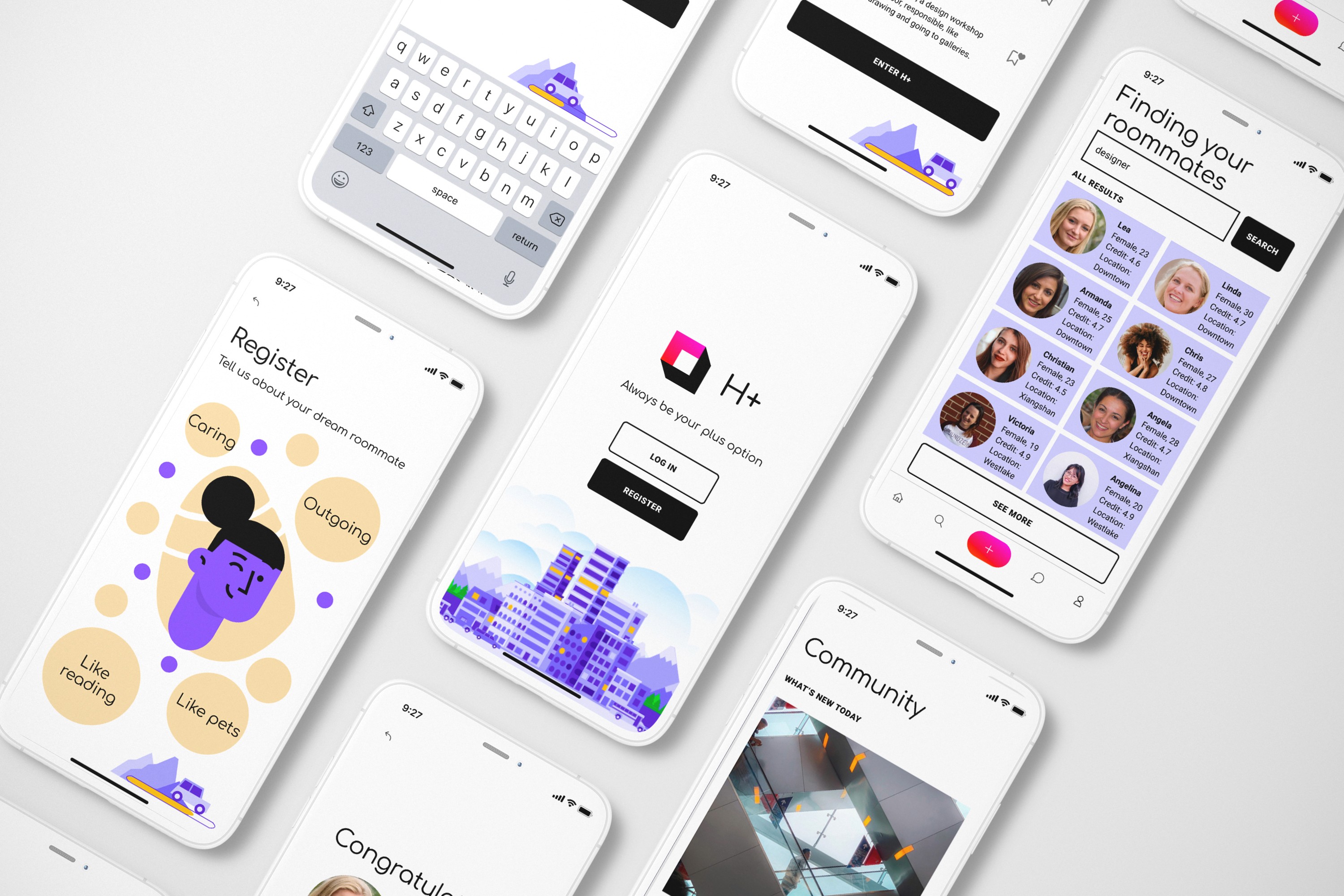App Design
H+/ A community app for traveller workers
Process Highlights
Challenge
Design a platform that balances the flexibility of short-term rentals with the need for community-driven connections among traveler workers.
Opportunity
Create a unique digital space that fosters belonging, promotes a work-meets-exploration culture, and enhances both user engagement and business growth.
Timeline
Feb 2021 - Jun 2021
Jan 2025 - present
Disciplines
User Experience Design
User Interface Design
Responsibilities
User Research
Sketching
UX/UI Mobile Design
Prototyping
Tools
Figma
Adobe PS
Procreate
Xmind
As working outside of one’s residency becomes increasingly common, many professionals struggle with a lack of belonging in their daily lives. While rental platforms help secure housing, they often overlook the need for community and social connections, leaving individuals isolated in unfamiliar environments.
In COVID period
With limited social interactions, people found it difficult to build connections and create a sense of home, increasing the need for stronger community bonds.
Post COVID period
As remote work grows, more professionals have the flexibility to travel while working, but finding affordable housing and meaningful local connections remains a challenge.
Process
Research
User Interview
Competitor Analysis
Affinity Map
Identifying Problems
Synthesis
Persona
User Journey
Ideation
Develop a Solution
User Flow
Low Fidelity
Mid Fidelity
Final Designs
Final Prototype
Major Redesigns
Reflection
Reflection
Conclusion
Research Pt.1
To understand the challenges of professionals relocating for work, I interviewed a self-media entrepreneur, a software engineer (SDE), and a product manager, all of whom moved to a new city for better opportunities.
Questions evolve around:
What challenges did you face when relocating for work?
How did you find housing, and what mattered most?
Have you struggled with roommate mismatches? Why?
Do you seek local communities, and how do you connect?
How does your living environment impact your work?
What’s missing in current rental platforms?



Research Pt.2
My competitor analysis explores how existing rental and community platforms cater to professionals working outside their residency, focusing on their experiences in finding housing, compatible roommates, and local connections. I aim to compare the features, user experience, and community-building aspects of platforms like Airbnb, Zillow, and Coliving.com to identify gaps and opportunities for improvement.
Airbnb
Key Features that stand out from competitors: Offers short-term rentals, co-living spaces, and unique accommodations worldwide, with a focus on travel experiences and local stays.
Pros
Global Housing Access: Airbnb provides access to diverse housing options in cities worldwide, catering to remote workers and travelers.
Flexible Stays: Users can choose from daily, weekly, or monthly rentals, making it suitable for professionals relocating temporarily.
User Reviews & Verification: Hosts and guests are verified, and reviews help ensure trust and safety.
Cons
Limited Community Engagement: While Airbnb offers accommodations, it lacks built-in features for connecting travelers or fostering a sense of belonging.
High Fees: Service fees for both hosts and renters can make long-term stays expensive compared to traditional rentals.
Coliving
Key Features that stand out from competitors: Offers short-term rentals, co-living spaces, and unique accommodations worldwide, with a focus on travel experiences and local stays.
Pros
Community-Oriented Living: Designed for remote workers, Coliving.com helps users find like-minded roommates and community-driven housing.
Fully Furnished Spaces: Offers move-in-ready accommodations with shared workspaces, reducing hassle for travelers.
Events & Networking: Many locations provide social events and networking opportunities.
Cons
Limited Locations: Availability is restricted to select cities and curated co-living properties.
Higher Costs: Compared to standard rentals, co-living spaces may be more expensive due to included amenities and community services.
Existing rental and co-living platforms focus on either short-term stays (Airbnb), community-driven housing (Coliving.com), or roommate matching (Roomi). However, none of them seamlessly combine housing, compatible roommate selection, and local community integration, highlighting a gap that H+ aims to fill.
Research Pt.3
After conducting user interviews and competitor analysis, I created an affinity map to identify common pain points among professionals working outside their residency. The map serves as a guide for redesigning the rental, community-building, and workspace experience, focusing on addressing key challenges in finding compatible roommates, securing housing, and accessing suitable workspaces while fostering a sense of belonging based on insights gathered from both user research and market analysis.
Breaking down the project
The design process for the fitness centre mobile app involved several key stages. Firstly, I conducted extensive user research to understand the needs of gym-goers and identify pain points with existing fitness apps.
Building on strong foundations
Based on this research, I developed user personas and created wireframes to map out the app’s functionality and structure. From there, I created a high-fidelity prototype and conducted usability testing to refine the design and improve the user experience. The final design included features such as a personalised workout tracker and an easy-to-use booking system.
Collaborating with the internal team
Throughout the process, I worked closely with the fitness centre’s team to ensure that the app met their requirements and aligned with their brand identity.
Outcome
The final outcome of the fitness centre mobile app was a user-friendly and engaging digital product that exceeded the client’s expectations.
Users were able to easily view class schedules, book sessions, and track their fitness progress, all within a seamless and intuitive app experience.
As a result, the fitness centre saw an increase in user engagement and loyalty, and the app has become an important part of their overall customer experience.





